
Daigasso! Band Brothers is a music video game published and developed by Nintendo for the Nintendo DS handheld game console. It was released in Japan on December 2, 2004 as a launch game for the Nintendo DS. The game features multiple songs, which include classical music, television themes, and video game music. The game is controlled using both the buttons on the DS as well as its touch screen in certain portions. It uses a variety of different instruments, which are combined selectively in order to compose a song. Besides the primary mode, players may play together, each one playing a different instrument in the song. Players may also compose their own songs. It was to be released in the United States as Jam with the Band, but was never released nor formally cancelled. It has a sequel titled Jam with the Band, which was released in Japan in 2008 and in Europe in 2010.
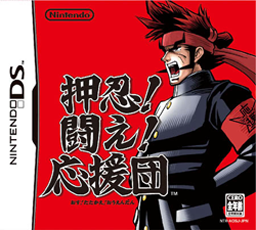
Osu! Tatakae! Ouendan, or Ouendan, is a rhythm video game developed by iNiS and published by Nintendo for the Nintendo DS handheld game console in 2005, for release only in Japan. Ouendan stars a cheer squad rhythmically cheering for various troubled people, presented in-game in the style of a manga comic. In each stage, players use the DS touchscreen to tap specifically marked spots that appear in rhythm to various Japanese pop songs, scoring points for accurate timing and avoiding a poor performance which can cause the stage to end prematurely. Though never released in Western markets, it was a popular import to these regions, leading to the development of the Westernized spiritual sequel Elite Beat Agents, as well as a direct Japanese sequel Moero! Nekketsu Rhythm Damashii Osu! Tatakae! Ouendan 2.
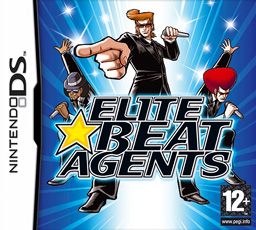
Elite Beat Agents is a rhythm video game developed by iNiS and published by Nintendo for the Nintendo DS. It was released in North America, Europe and South Korea. As the second of three rhythm games developed by iNiS specifically for the DS, it is the spiritual sequel and international counterpart to Osu! Tatakae! Ouendan, a Japanese rhythm game released in 2005, sharing many common elements with it.

Rhythm Tengoku is a rhythm game developed and published by Nintendo for the Game Boy Advance. It was originally released on August 3, 2006, and was the last game released by Nintendo for the Game Boy Advance. An arcade version of the game was reprogrammed and published by Sega on September 20, 2007. Both versions were released in Japan exclusively. The game was the first in the Rhythm Heaven series which spawned three international sequels; Rhythm Heaven, Rhythm Heaven Fever, and Rhythm Heaven Megamix. It began as an idea created by its composer and supervisor Tsunku, who proposed it to Nintendo due to his belief that they could do a better job with it than he could.
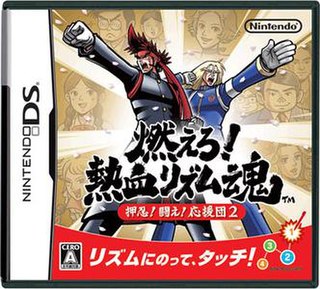
Moero! Nekketsu Rhythm Damashii: Osu! Tatakae! Ouendan 2 is a rhythm video game developed by iNiS and published by Nintendo for the Nintendo DS handheld video game console. It is the third of three rhythm games developed by iNiS for the DS, and is the sequel to Osu! Tatakae! Ouendan while incorporating many of the improvements in gameplay made in its international counterpart, Elite Beat Agents. The game has 4-player wireless play, supports the Nintendo DS Rumble Pak accessory, and was released in Japan on May 17, 2007.

Jubeat, stylized as jubeat, is a series of arcade music video games developed by Konami, and is a part of Konami's Bemani line of music video games. The series uses an arrangement of 16 transparent buttons in a 4x4 grid for gameplay, and each of the 16 buttons overlays a screen.
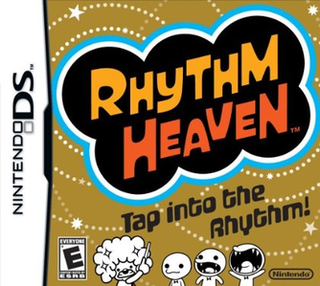
Rhythm Heaven, known as Rhythm Tengoku Gold in Japan, Rhythm Paradise in Europe, and Rhythm World in Korea, is a rhythm video game developed and published by Nintendo for the Nintendo DS. It is the second game in the Rhythm Heaven series and the first one released worldwide, following the Japan-only Game Boy Advance title Rhythm Tengoku, and was succeeded by Rhythm Heaven Fever for the Wii and Rhythm Heaven Megamix for the Nintendo 3DS. The game was released in Japan on July 31, 2008, in North America on April 5, 2009, in Europe on May 1, 2009, and in Australia on June 4, 2009.

Let's Tap is a video game developed by Yuji Naka's studio Prope and published by Sega for the Wii console. Along with Let's Catch, Let's Tap was the first game from Prope to be announced. Owners of Let's Tap can unlock content in Let's Catch. The game was later released as five individual applications for iOS.

Guitar Hero 5 is a 2009 rhythm game developed by Neversoft and published by Activision. It is the fifth main installment and the ninth overall installment in the Guitar Hero series. The game was released internationally in September 2009 for the PlayStation 2, PlayStation 3, Wii and Xbox 360 consoles. Similar to the preceding title, Guitar Hero World Tour (2008), Guitar Hero 5 is geared towards playing in a four-person band experience, including lead and bass guitar, drums, and vocals. The game is available as a standalone title, allowing players to use existing compatible instrument controllers, and as a bundle that provides these controllers. Guitar Hero 5 adds several new features, such as drop-in/drop-out play, bands composed of any combination of available instruments, a Rockfest competitive mode consisting of several various scoring mechanisms, and both song-specific and general Challenges to unlock new avatars, clothing, and other extras in the game. Many of these changes were added to make the game a more social experience, allowing players across a range of skill levels to be able to play cooperatively and competitively against each other both locally and online. The PlayStation 2 version is based on Guitar Hero World Tour, using the same gameplay UI as Guitar Hero: Metallica (2009), Guitar Hero Smash Hits (2009), and Guitar Hero: Van Halen (2009), albeit with a different Rock Meter design.

Bit.Trip Beat, marketed as BIT.TRIP BEAT, is an arcade-style music video game developed by Gaijin Games and published by Aksys Games for the Wii's WiiWare download service. It was released in 2009 in North America, and released in Japan and PAL regions in the same year. It was later released for the Windows and Mac OS X through the download service Steam in 2010, while Namco Bandai published it for iOS on iPod Touch, iPhone, and iPad in both Bit.Trip Beat and Bit.Trip Beat HD versions. Android and Linux versions debuted in the Humble Android Bundle 3.

Guitar Hero: On Tour is a series of music video games based on the Guitar Hero series for the Nintendo DS handheld game system. The series is developed by Vicarious Visions and published by Activision. Three games in the series have been released since June 2008: Guitar Hero: On Tour, Guitar Hero On Tour: Decades, and Guitar Hero On Tour: Modern Hits.

Zuma's Revenge! is a 2009 tile-matching puzzle video game developed and published by PopCap Games. It was released for Microsoft Windows and Mac OS X, as a sequel to the earlier 2003 video game, Zuma, and was later ported to Windows Phone.

Michael Jackson: The Experience is a music video game based on Michael Jackson's songs. It was developed and published by Ubisoft, and was released on 23 November 2010 in North America, 25 November 2010 in Australia and 26 November 2010 in Europe for the Nintendo DS, PlayStation Portable, and Wii. It was also released on 12 April 2011 in North America, 14 April 2011 in Australia and 15 April 2011 in Europe for PlayStation 3's PlayStation Move and Xbox 360's Kinect. The Japanese release on 8 December 2011 only revised the PlayStation 3, Xbox 360, and Wii consoles. The game features many of Michael Jackson's hits, such as "Bad", "Thriller", "Beat It", "Billie Jean", "Smooth Criminal", "Black or White", "The Way You Make Me Feel", etc. However, some songs like "Man in the Mirror" and "P.Y.T. " are excluded. Initial launches of the game included a limited edition replica of Jackson's sequined glove. It was later released for the Nintendo 3DS on 7 November 2011 in North America and 11 November 2011 in Europe, for iPhone and iPad on 7 December 2011 in North America and for PlayStation Vita on 15 February 2012 in North America, 22 February 2012 in Europe and 23 February 2012 in Australia. It was announced that the game would be released on Mac OS X, and iPad 2. The game sold 2 million units in two months, not including Japanese sales, making it one of the best-selling Wii title games.
A number of adventure/rhythm video games based on the Disney Channel show Hannah Montana and the film have been released. All the games were published by Buena Vista Games / Disney Interactive Studios.

Bit.Trip Flux, marketed as BIT.TRIP FLUX, is an arcade-style rhythm game developed by Gaijin Games and published by Aksys Games and QubicGames as the sixth and final game of the main Bit.Trip series. It was released for the Wii's WiiWare download service on February 25, 2011, which was later ported to Microsoft Windows and OS X. It was released on the Steam platform on June 5, 2014, and was ported to the PlayStation 4 and Nintendo 3DS as part of a collection later on. A standalone version was released on Nintendo Switch on December 25, 2020.

Rhythm Heaven Fever, known in the PAL regions as Beat the Beat: Rhythm Paradise, Minna no Rhythm Tengoku in Japan and Rhythm World Wii in Korea, is a music video game developed by Nintendo and TNX for Nintendo's Wii. It is the third game in the Rhythm Heaven series, following Rhythm Tengoku for the Game Boy Advance and Rhythm Heaven for the Nintendo DS, and was succeeded by Rhythm Heaven Megamix for the Nintendo 3DS in 2016. The game was released in Japan on July 21, 2011, in North America on February 13, 2012, in Europe on July 6, 2012, and in Australia on September 13, 2012. It was digitally re-released for the Wii U in Japan on July 27, 2016, in North America on November 10, 2016, and in Europe on November 22, 2016.

Theatrhythm Final Fantasy is a rhythm video game, developed by indieszero and published by Square Enix for Nintendo 3DS and iOS. Based on the Final Fantasy video game franchise, the game involves using the touch screen in time to various pieces of music from the series. The game was released in Japan in February 2012, and in North America, Australia and Europe in July. An iOS version was released in December. A sequel, Theatrhythm Final Fantasy: Curtain Call, was released in 2014. A third game based on the Dragon Quest series, Theatrhythm Dragon Quest, was released in 2015. An arcade game, Theatrhythm Final Fantasy: All-Star Carnival, was released in 2016. A second sequel, Theatrhythm Final Bar Line, was released on February 16, 2023 for Nintendo Switch and PlayStation 4.
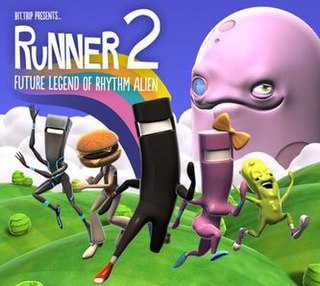
Bit.Trip Presents... Runner2: Future Legend of Rhythm Alien is a 2013 side-scrolling platformer developed by Gaijin Games. The game is the sequel to Bit.Trip Runner (2010) and was released as a downloadable title on PlayStation 3, PlayStation Vita, Xbox 360, Wii U, Microsoft Windows, OS X, Linux, and iOS. Versions for PlayStation 4 and Nintendo Switch were later released in 2016 and 2024 respectively. The PC, Mac, Linux, and Wii U versions were self-published by Gaijin Games, and the Xbox 360 and PlayStation 3 versions were published by Aksys Games.

The Groove Coaster series is an iOS / Android and arcade rhythm game franchise developed by Matrix Software and published by Taito. The first Groove Coaster was released for iOS on July 28, 2011. This rhythm game follows a roller coaster type track on screen, where players must make the appropriate controller inputs. Like many rhythm games, a life bar is attached to the game play. Players gain or lose points on the bar depending on the input timings.

Runner3 is a rhythm platform game developed by Choice Provisions. A sequel to Bit.Trip Presents... Runner2: Future Legend of Rhythm Alien, Runner3 is part of the Bit.Trip series, starring the character CommanderVideo. The game was released on May 22, 2018 on Microsoft Windows, macOS, and Nintendo Switch, and was released on the PlayStation 4 on November 13, 2018.



















